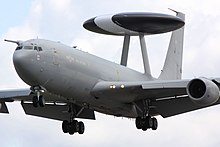Radome



Aradome(aportmanteauofradaranddome) is a structural, weatherproof enclosure that protects a radarantenna.[1]The radome is constructed of material transparent to radio waves. Radomes protect the antenna from weather and conceal antenna electronic equipment from view. They also protect nearby personnel from being accidentally struck by quickly rotating antennas.
Radomes can be constructed in several shapes – spherical,geodesic,planar, etc. – depending on the particular application, using various construction materials such asfiberglass,polytetrafluoroethylene (PTFE)-coated fabric, and others.[2]
In addition to radar protection, radomes onaircraftplatforms also act asfairingsthat streamline the antenna system, thus reducingdrag.When found onfixed-wing aircraftwith forward-looking radar, as are commonly used for object or weather detection, thenose conesoften additionally serve as radomes. Onairborne early warning and control(AEW&C) aircraft (e.g. the AmericanE-3 Sentry), adiscus-shaped rotating radome, often called a "rotodome",is mounted on the top of thefuselagefor 360-degree scanning coverage. Some newer AEW&C configurations instead use three 120-degreephased arraymodules inside a stationary radome, examples being the ChineseKJ-2000and IndianDRDO AEW&Cs.On fixed-wing androtary-wingaircraft usingmicrowavesatelliteforbeyond-line-of-sight communication,radomes often appear as bulged "blisters" on the fuselage.[3]
The air supported radome built by Walter Bird in 1948 at theCornell Aeronautical Laboratoryis the first pneumatic construction built in history.[4][2]
Use
[edit]
A radome is often used to prevent ice andfreezing rainfrom accumulating on antennas. In the case of a spinning radarparabolic antenna,the radome also protects the antenna from debris and rotational irregularities due to wind. Its shape is easily identified by its hardshell, which has strong properties against being damaged.
Stationary antennas
[edit]For stationary antennas, excessive amounts of ice can de-tunethe antenna to the point where itsimpedanceat the inputfrequencyrises drastically, causing thevoltage standing wave ratio(VSWR) to rise as well. This reflected power goes back to thetransmitter,where it can causeoverheating.Afoldbackcircuitcan act to prevent this; however, one drawback of its use is that it causes the station's output power to drop dramatically, reducing its range. A radome avoids that by covering the antenna's exposed parts with a sturdy, weatherproof material, typically fiberglass, keeping debris or ice away from the antenna, thus preventing any serious issues. One of the main driving forces behind the development of fiberglass as a structural material was the need duringWorld War IIfor radomes.[5]When considering structural load, the use of a radome greatly reduces wind load in both normal and iced conditions. Many tower sites require or prefer the use of radomes for wind loading benefits and for protection from falling ice or debris.
Where radomes might be considered unsightly if near the ground, electric antenna heaters could be used instead. Usually running ondirect current,the heaters do not interfere physically or electrically with thealternating currentof the radiotransmission.
Radar dishes
[edit]For radar dishes, a single, large, ball-shaped dome also protects the rotational mechanism and thesensitiveelectronics,and is heated in colder climates to prevent icing.
TheRAF Menwith Hillelectronic surveillance base, which includes over 30 radomes, is widely believed to regularly interceptsatellitecommunications. At Menwith Hill, the radome enclosures prevent observers from seeing the direction of the antennas, and therefore which satellites are being targeted. Similarly, radomes prevent observation of antennas used inECHELONfacilities.
The United States Air Force Aerospace Defense Command operated and maintained dozens of air defense radar stations in the contiguous United States and Alaska during the Cold War. Most of the radars used at these ground stations were protected by rigid or inflatable radomes. The radomes were typically at least 15 m (50 ft) in diameter and the radomes were attached to standardized radar tower buildings that housed the radar transmitter, receiver and antenna. Some of these radomes were very large. The CW-620 was a space frame rigid radome with a maximum diameter of 46 m (150 ft), and a height of 26 m (84 ft). This radome consisted of 590 panels, and was designed for winds up to 240 km/h (150 mph). The total radome weight was 92,700 kg (204,400 lb) with a surface area of 3,680 m2(39,600 sq ft). The CW-620 radome was designed and constructed by Sperry-Rand Corporation for the Columbus Division of North American Aviation. This radome was originally used for the FPS-35 search radar at Baker Air Force Station, Oregon. When Baker AFS was closed the radome was moved to provide a high-school gymnasium in Payette, Idaho. Pictures and documents are available online atradomes.org/museumfor Baker AFS/821st Radar Squadron.
Maritime satellites
[edit]
Formaritimesatellite communicationsservice, radomes are widely used to protect dish antennas which are continually tracking fixed satellites while the ship experiences pitch, roll and yaw movements. Large cruise ships and oil tankers may have radomes over 3m in diameter covering antennas for broadband transmissions for television, voice, data, and the Internet, while recent developments allow similar services from smaller installations such as the 85 cm motorised dish used in theSES Broadband for Maritimesystem. Small private yachts may use radomes as small as 26cm in diameter for voice and low-speed data.
Alternatives
[edit]Anactive electronically scanned arrayradar has no moving antenna and so a radome is not necessary.[2]An example of this is the pyramid which replaced the golfball-style radome installations atRAF Fylingdales.
Notes
[edit]- ^Wragg, David W. (1973).A Dictionary of Aviation(first ed.). Osprey. p. 220.ISBN9780850451634.
- ^abcLatifiyan, Pouya (August 28, 2022)."What is Radome?".Qoqnoos Scientific Magazine.1:13.
- ^example of helicopter radome
- ^Collado Baíllo, Isabel."Walter Bird y las primeras construcciones neumáticas".Revista Europea de Investigación en Arquitectura.20:119–140.
- ^Gordon, J.E.,The New Science of Strong Materials: 2nd Edition, Pelican, 1976.
External links
[edit]- Photograph of Mount Hebo while activeoverlooking Pacific Ocean
